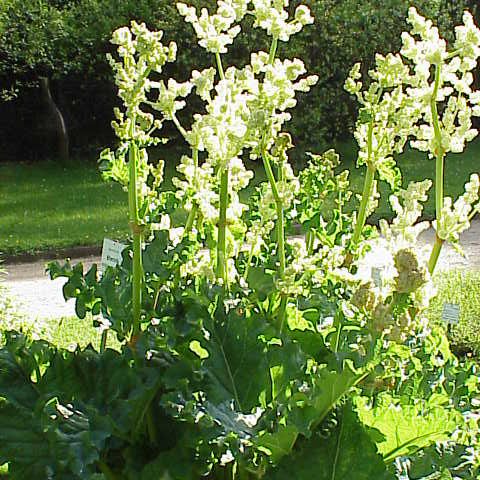Herbs large, 1.5-2 m tall. Rhizomes and roots stout. Stem stout, hollow, finely sulcate, with white hairs, especially above and at nodes. Petiole of basal leaf terete, ca. as long as blade or slightly shorter, pubescent; leaf blade orbicular, rarely broadly ovate, large, 30-50 cm in diam., or longer than wide, abaxially pubescent, adaxially glabrous, rarely pubescent along veins, basal veins 5-7, base subcordate; palmatilobate, apex subacute. Stem leaves smaller upward; ocrea large, to 15 cm, broad, outside with dense hairs. Panicles large; branches spreading. Pedicel 3-3.5 mm, slender, jointed below middle. Flowers 4-or 5-fascicled. Tepals 6, green to yellow-white, elliptic or narrowly elliptic, 2-2.5 × 1.2-1.5 mm. Stamens shorter than perianth. Style deflexed; stigma inflated. Fruit oblong-ellipsoid, 8-10 × 7-9 mm; wings ca. 3 mm wide, with longitudinal veins near margin. Seeds broadly ovoid. Fl. May-Jun, fr. Aug-Sep.
More
A herb that keeps growing from year to year. It grows 1-15 cm high. It has a thick rhizome or underground stem. The leaves near the base have long leaf stalks. They are 15-30 cm long and 1-2 cm thick and fleshy. The leaf blades are almost round and 30-60 cm long and wide. They can have lobes. The flowers are greenish-white. They are in groups at the top of the plant. The fruit are dry and one seeded and with wings.
The dried rhizomes are used to make tonic wines and other alcoholic drinks. Caution: Alcohol is a cause of cancer. Extracts of the root are used to flavour bitter tonics, drinks, syrups, and baked goods. The stalks are eaten as a snack. Caution: The leaves contain oxalates and are poisonous.

